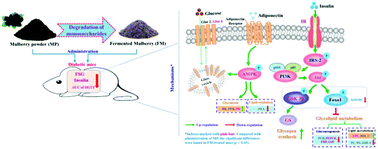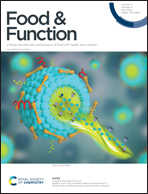Superior hypoglycemic activity of mulberry lacking monosaccharides is accompanied by better activation of the PI3K/Akt and AMPK signaling pathways
Abstract
Mulberry has been used as a functional food to treat type 2 diabetes mellitus (T2DM). However, it contains relatively high levels of fructose and glucose, which are not suitable for excess consumption by diabetic patients. In this study we used microbial fermentation to remove fructose and glucose from mulberry fruit, and then determined the effects on glycemia, the phosphatidylinositol 3-hydroxykinase/Akt (PI3K/Akt) and adenosine monophosphate-activated protein kinase (AMPK) signaling pathways and their downstream effectors in T2DM mice. After 5 weeks of administration, fermented mulberry (FM) significantly reduced fasting blood glucose, and also improved insulin sensitivity and glucose tolerance, more effectively than unfermented mulberry (MP). Moreover, compared with MP, FM had a more marked effect on the protein expression of intermediates in the PI3K/Akt and AMPK signaling pathways and their effectors: insulin receptor, phosphorylated Akt (Ser 308), phosphorylated glycogen synthase kinase-3β (Ser 9), glycogen synthetase, phosphorylated forkhead transcription factor 1 (Ser 256), pyruvate carboxylase, phosphoenolpyruvate carboxykinase, fructose-1, 6-bisphosphatase, glucose-6-phosphatase, lipoprotein lipase, and phosphorylated AMPK (Thr 172), glucose transporter 4 and pyruvate kinase. These findings indicate that mulberry fruit modified to remove fructose and glucose may be more promising than whole mulberry as a treatment for diabetes.



 Please wait while we load your content...
Please wait while we load your content...